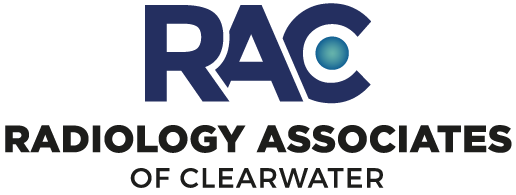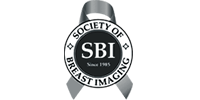Vericose Vein Treatment
Interventional Radiology Nonsurgical Outpatient Procedure Treats Varicose Veins
Venous insufficiency is a very common condition resulting from decreased blood flow from the leg veins up to the heart, with pooling of blood in the veins. Normally, one-way valves in the veins keep blood flowing toward the heart, against the force of gravity. When the valves become weak and don't close properly, they allow blood to flow backward, a condition called reflux. Veins that have lost their valve effectiveness, become elongated, rope-like, bulged, and thickened. These enlarged, swollen vessels are known as varicose veins and are a direct result of increased pressure from reflux. A common cause of varicose veins in the legs is reflux in a thigh vein called the great saphenous, which leads to pooling in the visible varicose vein below.
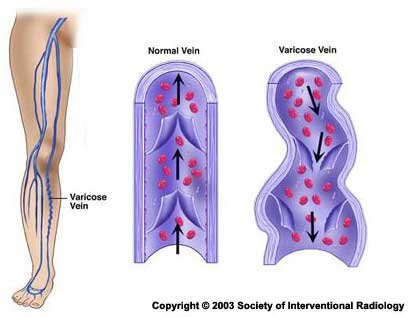
Prevalence of Varicose Veins and Venous Insufficiency
Chronic venous disease of the legs is one of the most common conditions affecting people of all races.
- Approximately half of the U.S. population has venous disease--50 to 55% of women and 40 to 45% of men. Of these, 20 to 25% of the women and 10 to 15% of men will have visible varicose veins.
- Varicose veins affect 1 out of 2 people age 50 and older, and 15 to 25% of all adults.
Risk Factors
- Age
- Family history
- Female gender
- Pregnancy, especially multiple pregnancies, is one of the most common factors accelerating the worsening of varicose veins.
Symptoms
Symptoms caused by venous insufficiency and varicose veins include aching leg pain, easy leg fatigue, and leg heaviness, all of which worsen as the day progresses. Many people find they need to sit down in the afternoon and elevate their legs to relieve these symptoms. In more severe cases, venous insufficiency and reflux can cause skin discoloration and ulceration which may be very difficult to treat. One percent of adults over age 60 have chronic wounds known as ulcers.
People without visible varicose veins can still have symptoms. The symptoms can arise from spider veins as well as from varicose veins, because, in both cases, the symptoms are caused by pressure on nerves by dilated veins.
Diagnosis and Assessment
An interventional radiologist, a doctor specially trained in performing minimally invasive treatments using imaging guidance, will use duplex ultrasound to assess the venous anatomy, vein valve function, and venous blood flow changes, which can assist in diagnosing venous insufficiency. The doctor will map the great saphenous vein and examine the deep and superficial venous systems to determine if the veins are open and to pinpoint any reflux. This will help determine if the patient is a candidate for a minimally invasive treatment, known as vein ablation.
Varicose Vein Treatments
Minimally Invasive Vein Ablation Treatment
This minimally-invasive treatment is an outpatient procedure performed using imaging guidance. After applying local anesthetic to the vein, the interventional radiologist inserts a thin catheter, about the size of a strand of spaghetti, into the vein and guides it up the great saphenous vein in the thigh. Then laser or radiofrequency energy is applied to the inside of the vein. This heats the vein and seals the vein closed.
Reflux within the great saphenous vein leads to pooling in the visible varicose veins below. By closing the great saphenous vein, the twisted and varicosed branch veins, which are close to the skin, shrink and improve in appearance. Once the diseased vein is closed, other healthy veins take over to carry blood from the leg, re-establishing normal flow.
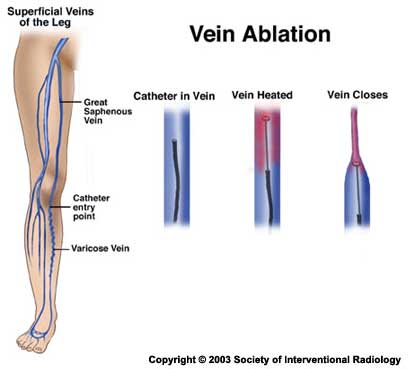
Benefits of Vein Ablation Treatment
- The treatment takes less than an hour and provides immediate relief of symptoms.
- Immediate return to normal activity with little or no pain. There may be minor soreness or bruising, which can be treated with over-the-counter pain relievers.
- No scars or stitches - because the procedure does not require a surgical incision, just a nick in the skin, about the size of a pencil tip.
- High success rate and low recurrence rate compared to surgery.
- The success rate ranges for vein ablation ranges from 93 - 95 percent.
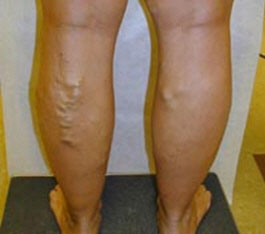
Before Vein Ablation, photo courtesy of Dr. Robert Min
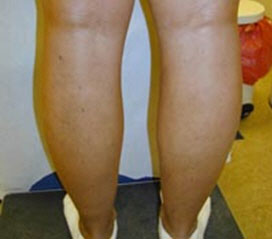
After Vein Ablation, photo courtesy of Dr. Robert Min
Insurance
Many insurance carriers cover the vein ablation treatment, based on medical necessity for symptom relief.
Surgical Treatment of Veins
Traditionally, surgical ligation or vein stripping was the treatment for varicose veins, but these procedures can be quite painful and often have a long recovery time. In addition, there are high rates of recurrence with the surgical procedures. One study found a 29% recurrence rate after ligation and stripping of the greater saphenous vein, and a rate of 71% after high ligation. These recurrence rates are similar to those reported in other studies.
Second Opinion
Patients considering surgical treatment should also get a second opinion from an interventional radiologist to ensure they know all of their treatment options. You can ask for a referral from your doctor, call the radiology department of any hospital and ask for interventional radiology or visit the doctor finder link at the top of this page to locate a doctor near you.
Additional Treatments for Varicose Veins
Ambulatory Phlebectomy
A minimally invasive surgical technique used to treat varicose veins that are not caused by saphenous vein reflux. The abnormal vein is removed through a tiny incision or incisions using a special set of tools. The procedure is done under local anesthesia, and typically takes under an hour. Recovery is rapid, and most patients do not need to interrupt regular activity after ambulatory phlebectomy.
Injection Sclerotherapy
Can also be used to treat some varicose and nearly all spider veins. An extremely fine needle is used to inject the vein with a solution which shrinks the vein.
Ultrasound-guided Sclerotherapy
Involves an interventional radiologist passing a thin tube called a catheter into the vein using ultrasound guidance and injecting substance that causes the veins to scar and close - rerouting the blood to healthier veins. The affected vein forms a knot of scar tissue that is absorbed by the body over time.
From Society of Interventional Radiology 2008
- Home
- About Us
- Physicians
- Technology
-
Services
- General Radiology
-
Interventional Radiology
- Angiography
- Chemoembolization
- Radiofrequency Ablation
- Uterine Artery Embolization
- Vericose Vein Treatment
- Arthrography
- Discography
- Epidural Steroid Injections
- Epidurography
- Facet Joint Injections
- Kyphoplasty
- MRI Arthrography
- Nerve Root Blocks
- Radiofrequency Rhizotomy
- Sacroiliac Joint Injection
- Trigger Point Injections
- Stellate Ganglion Block
- Vertebroplasty
- Facet Nerve Injection
- Myelogram
- Neuroradiology
- Women's Imaging and Interventions
- Orthopedic and Sports Imaging
- Oncological Diagnostics and Interventions
- Cardiovascular Radiology
- Locations
- Contact
